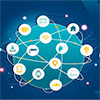| Sep 21, 2022 |
|
|
|
(Nanowerk News) We can learn new idioms and interact with people from other countries – and, so can electronic systems. There are many ways to learn new languages, but we cannot deny that there is an element which can prove to be very helpful when travelling abroad: a dictionary. But, what does a dictionary have to do with semantic interoperability? And how does this relate to the digitalisation of the energy sector? Let’s go through it.
|
What is the Semantic Interoperability Framework (SIF)?
|
|
“Over the past years, a large number of R&D and innovation projects have been implementing services in two major domains: smart grids and smart homes/buildings, which together with Information and Communications Technologies (ICT) pave the future energy system paradigm, where digital-based marketplaces will allow prosumers to easily trade energy and services”, said David Rua, Researcher at the Portuguese Institute for Systems and Computer Engineering, Technology and Science (INESC TEC) and coordinator of InterConnect.
|
|
The researcher explained, however, that there is one remaining challenge: “an integrated understanding of how existing and emerging technologies can be put into operation, considering the roles and expectations of different stakeholders, and enable new business models that ensure interoperability, security, and data privacy. This is where semantic interoperability can play a key role, with significant impact.”
|
|
This is especially critical since the energy sector has been facing an unprecedented transformation towards digitalisation and efficient use of energy resources. InterConnect is producing a digital marketplace of interoperable services as part of its Semantic Interoperability Framework (SIF), based on Internet of Things (IoT) reference architectures and ontologies like SAREF (Smart Applications REFerence ontology).
|
|
“InterConnect sees semantic interoperability as crucial to the provision of truly interconnected services and solutions that can provide actual value to end-users and engage them in their important role to better manage energy, which is a high-value commodity” saidys David Rua.
|
How does the SIF work?
|
|
SAREF is used as the basis for semantic interoperability. It acts as a dictionary, on which everyone depends, containing well-understood, non-arguable representations of assets. In this sense, a washing machine can, for instance, intelligently issue notifications based on the data collected, such as how to use household appliances to monetise energy of the house through a simple suggestion of operating hours.
|
|
The Semantic Interoperability Framework (SIF), designed by the InterConnect project and publicly available, will allow different stakeholders to focus on the development of innovative and interoperable services towards a human-centric energy ecosystem. The SIF and its semantic adapters, are tools for companies and providers to implement their next generation services.
|
|
The SIF allows semantic representations to be used in the data exchange between different digital platforms from manufacturers and service providers. With it, energy and non-energy services are created, focusing on comfort, energy savings and lifestyle.
|
|
Regardless of the brand and origin of the product, it becomes possible to communicate between smart appliances and energy management systems, establishing intelligent communication between them, while creating the interoperable energy ecosystem of the future.
|
|
“Semantic interoperability is the cornerstone of InterConnect’s interoperability concept; it enables the exchange of knowledge between digital systems without having to rely on closed APIs (but rather on open ones) and on the underlying dependency towards specific implementations made by manufacturers. The SIF is the toolset that InterConnect brings to the table, and it is the foundation of the contributions of several partners in making interoperability accessible to every developer and integrator. It facilitates cross-sector services, with a positive impact on energy use”, added Fábio Coelho, Researcher at INESC TEC.
|
How will it be tested?
|
|
The project is demonstrating the use of SIF with different IoT technologies in seven large-scale pilots, with the implementation of several energy and non-energy services supported by different platforms to address end-users’ needs with cost-effective solutions. The purpose is to allow different market agents to create value, ensuring high-level cybersecurity and privacy.
|
|
“The pilots, which are market-driven, are being deployed in Portugal, Belgium, Germany, the Netherlands, Italy, Greece and France, with different end-users, from domestic to tertiary buildings”, stated David Rua, explaining that the pilots aim to guarantee representativeness and dimension in terms of number of technologies and services adopted. “Pilots are demonstrating a real digital market environment over energy leveraging on the flexibility of energy resources, reducing operational and investment costs, which will benefit energy end-users and help the European Union achieve its energy efficiency objectives. Moreover, and besides the consortium partners, the recently launched open calls will bring more companies to the game and increase the impact on the demonstration activities”.
|
Project outcomes
|
|
All the outcomes of the project will be presented in Brussels, at a public event – Towards the Interoperable energy ecosystem of the future”. The event will take place on September 27, during the European Energy Sustainable Week, and will bring together representatives of the European Commission, Industry, Academia, and Research.
|
|
The event will address key issues like data exchange, focusing on existing concepts of data formats and data standards in different sectors, e.g., buildings, mobility, and energy, and explorer how it facilitates data sharing between sectors based on a common data framework
|
|
The participation is free, but registration is mandatory. Further details available here.
|
